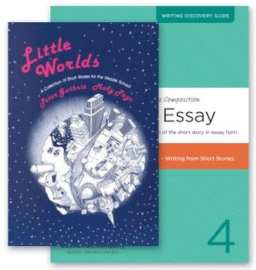Blackbird & Company began their The Essay series with three courses that provide an introduction to essay writing. This review covers the next three courses, which are appropriate for high school students:
Intermediate Composition: The Essay - Volume 4 - Writing from Short Stories
Intermediate Composition: The Essay - Volume 5; Write the Persuasive Essay!
Advanced Composition: The Essay - Volumes 6A and 6B: Research: Person/Place/Thing
Volume 4 and Volume 5 should take ten weeks each to complete. Volume 6 takes 30 weeks. Note that the publisher’s website suggests using Volume 6 in both eleventh and twelfth grades, completing the process of writing a different research paper each year. You can use each course on its own, but the sequence of the three courses works well together.
These courses build on students’ prior experience with essay writing by giving them very detailed “blueprints” for writing essays and a research paper. The course guides provide questions and pre-writing assignments that assist students through the steps of the writing process. Students are provided with space to do much of their prewriting and notetaking directly in the books.
For each assignment, students must have a conference with a parent, teacher, or knowledgeable person who will go over their work before they write their final drafts. While students can do most of their work independently, the conference is an essential component. Evaluation rubrics are included for each course.
Volume 4
The first of these three courses, Volume 4, uses five short stories from the anthology required for the course, Little Worlds: Short Story Classics to Inspire Readers. (This book is sold with the course guide as a bundle.) The course guide requires students to write a five-paragraph essay for each story over a two-week period, following the same detailed outline. For each essay, students form their own thesis statement and three supporting points, then develop them following a very specific format. For instance, two supporting ideas are to be included in each paragraph of the body with a quotation from the story to support each one.
Students are required to create a Works Cited page to attach to each essay, even though the work cited might be only the story upon which the essay is based. Quotations used in the essays are to be followed by page citations. Stories, such as Eudora Welty’s “A Visit of Charity,” serve as the source material, and they have been carefully selected so that each story offers at least a few potential themes that students might choose. These stories provide students with well-crafted, thought-provoking material to spark ideas. A sample essay at the beginning of the guide shows exactly how each sentence of the essay fits the required format.
Through the process, students learn to write literary analysis essays along with the conventions for including citations.
Volume 5
Volume 5 uses the five-paragraph essay form to teach techniques for writing persuasive essays. The blueprint for the five essays students will write requires them to take a point of view on topics such as “The Arts: Waste or Worthy?” and “Little Lies: For or Against?” Their essays must include three arguments that support their thesis statement. For each argument, along with their supporting points, they must also include and refute an opposing point.
As in Volume 4, pre-writing questions help students think through possible ideas, but those questions in Volume 5 are weighted toward only one position for four of the essay assignments. (The exception is the assignment to choose their own topic to write about, “Something Worth Fighting For.”) This means that students might need to be especially creative in coming up with counterarguments against each of their points. It’s like developing debate skills, figuring out the arguments most likely to be used by an opponent, and then coming up with counterarguments. But this is difficult to do when one position, such as the positive value of the arts, is clearly easier to defend than the negative.
To help students understand the required format for each essay, the guide has a sample essay with inserted comments that show how each sentence fulfills the requirements.
Volume 6
Volume 6, presented in two books labeled A and B, walks students through the process of writing a research paper. However, the theme of the paper must be developed in a particular fashion. Volume 6A suggests themes such as family, redemption, courage, and compassion (p. 10), then requires students to develop their theme in three parts, with a person, a place, and a thing. This is a challenging type of essay to write because of the skill required to weave the person, place, and thing together around a common theme. This is an unusual approach, so a sample student essay, titled “On Tragedy: Lincoln Terezin, and Escalators,” is used as a model throughout the course. (The sample essay is included along with the two books in the course bundle.)
The two books for the course are labeled (6A) Student Lessons & Notes: Weeks 1-11 and (6B) Student Draft Workbook: Weeks 12-30. The titles make it sound like all the instruction is in the first book, but that’s not the case. Students will do plenty of prewriting in the first book. They begin drafting their research paper in the second book, but it continues to provide instruction and guidance.
Students are instructed to use several resources, including at least one book, and they will create a Works Cited page to attach to their completed paper.
Summary
The Essay: Intermediate and Advanced Composition courses take students beyond the essentials of a five-paragraph essay and a research paper by requiring particular structural elements. The discipline of the forms might seem limiting at first, but it teaches students how to write and defend their ideas with both logic and evidence, while simultaneously teaching them stylistic techniques that make what they write interesting to read.









